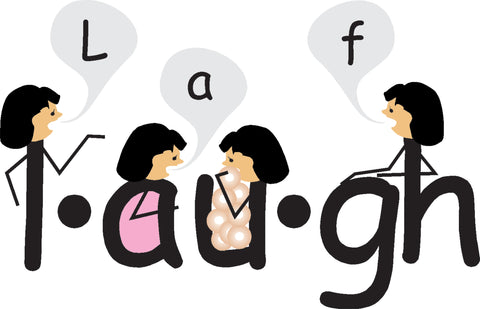Teaching Sound Spelling Patterns Part 2
Last week we looked at how teaching sound spelling patterns helps students derive meaning, improve comprehension, and experience success in reading. Today, we are going to take a deeper look at the OUGH spelling pattern, as well as an AUGH word.
How to Teach Laugh

Write some short words with the short A sound on a whiteboard in a column and sound them out with the children. And then, dramatically announce that you have a special word to introduce.
Write the word “laugh” in large letters to one side of the column of words. Say, “The word LAUGH starts with the sound of ‘L’ (say the sound, not letter name), but from there, it gets really confusing! So, let’s go to the end of the word and talk about that next.” Underline the GH and then in small print beside that part of the word, write the words “rough, tough, enough” underlining the GH in those words as well. Say, “The GH in these words doesn’t say, ‘guh, huh,’ (say the sounds) but instead, the letters work together to say, ‘ffff’!”
“Now, look at the middle of the word LAUGH again. If the L says, ‘lllll’, the GH says, ‘ffff,’ the middle two letters must say, ‘A’ (sound of short vowel A). For some reason, the U is not sounding at all, it is not working with the A to say, (sound of short) ‘A’. It is just sitting there, and I think I know why!”
At this point, draw some donut shapes inside the U until it is full to the top. Say, “The U just took a big bite and cannot say a single sound, so the A will make the sound by itself!” Underline the A in the word LAUGH. Now you can sound out the word LAUGH with the children. “L-A (au) –F (gh)”
NOTE: LAUGH and COUGH both have GH saying, “FFF,” and a U with a full mouth. Write both words and let the children act out alternating between coughing and laughing.
How to Teach Enough

Refer to the mini-lesson for LAUGH. This word LAUGH has a very similar cast of characters. But instead of the AUGH, this word has OUGH. The thing that is similar, however, is the GH sounding like FF. But don’t immediately tell the children this. Ask them what is similar about the words ENOUGH and LAUGH, and what is different.
The words are sounded out like this:
“E-N-OUGH (ENUF) and L-AU-GH (LAF)”
Two other words that go with this UF sound spelling are:
rough
tough
Look at the words rough, tough, and enough and ask the children to help you figure out which letter in those words has its mouth full. The O is the one with a full mouth, leaving the U to say UH by itself!
Share this sentence with the children and have them write it first, and then color in the letters who are along for the ride! Then they can illustrate the sentence.
They are rough and tough enough.
Who or what do they think is rough and tough enough?
How to Teach Through

Show the children the image on the front and tell them the word says THROUGH. Now, ask them to be detectives and figure out what is going on in this word.
It appears that some of the letters are not talking at all! Could it be they are eating donuts and their mouths are so full that they can’t speak? I think so!
Show them the SnapWord® of the word THROUGH, which has the snake slithering THROUGH the letters in the word. This visual will help them know what the word says, and it will also help with spelling and phonics if you park on the sound spelling pattern OUGH for a bit.
Do the body motions to go with the OUGH spelling:
Draw “OUGH” in lowercase letters on your whiteboard and ask the children if they notice anything about these letters. What I notice immediately is that the first letter is closed (and they can make the motion for this letter by making a big circle with their arms) and the next letter is open like a bowl. They can make the bowl with their arms held up. The next letter is closed again just like the first one, and then the h is open but pointing down. So, the body motion for this sound spelling is circle, bowl, circle, upside down bowl.

It will be worthwhile to leave this sound spelling visible for several days because there are six ways in all that these letters are used: the sound of Long O as in THOUGH, the sound of UF as in ENOUGH, the sound of OFF as in COUGH, the sound of OOOO as in THROUGH, the sound of short O as in THOUGHT, and the sound of OU as in DROUGHT. WOW!
Have the children write and embellish the word THROUGH. Remember, it takes all the letters to do something. The four letters are there to make the OOOO sound, but only one of the letters is working. The others are just eating away!
How to Teach Thought

Refer to the mini-lesson on the back of the THROUGH sound spelling card. This word, THOUGHT, has a very similar cast of characters. Again, the letter O is doing all the work. She does get tired of always saying the same thing, however, so this time she is saying, “O,” as in POT.
Write the word on your whiteboard and have the children make the body motions for OUGH from the lesson on THROUGH. (Circle, bowl, circle, upside down bowl.)
Even though this word is very long, there are only three little sounds! “TH, O, and T.” Have the children sound the word out with you and then practice writing it on their own whiteboards. Please have them look at the picture, but then when it is time to write the word, have them NOT look. Instead, they can refer to the visual in their head, they can refer to the body motions of OUGH to remind them, and finally, they can sound out the word. All these tools are inside their own brains!
How to teach Though

This word is very similar to THOUGHT, THROUGH, and ENOUGH. In THOUGH, the O is still doing all the work while the UGH letters are goofing off! In this case, maybe O is saying, “OH, I know! Next time I won’t bring donuts so you guys will actually help me!”
Review the body motions from before, having the children do them with you: Circle, bowl, circle, upside down bowl, using the arms to make the circles and bowls.
Conclusion
Sound spellings don’t have to be troublesome! When you add multisensory elements to the lesson, learning becomes fun and less stressful. Try this lesson today and see how much of a difference it makes with your child!
You can download larger images of the words above for teaching.
You can also download these plain words for the students to embellish and write about.
Previous blogs in this series: Teaching Sound Spelling Patterns Part 1
We are here to help; please contact us with any questions!



Leave a comment